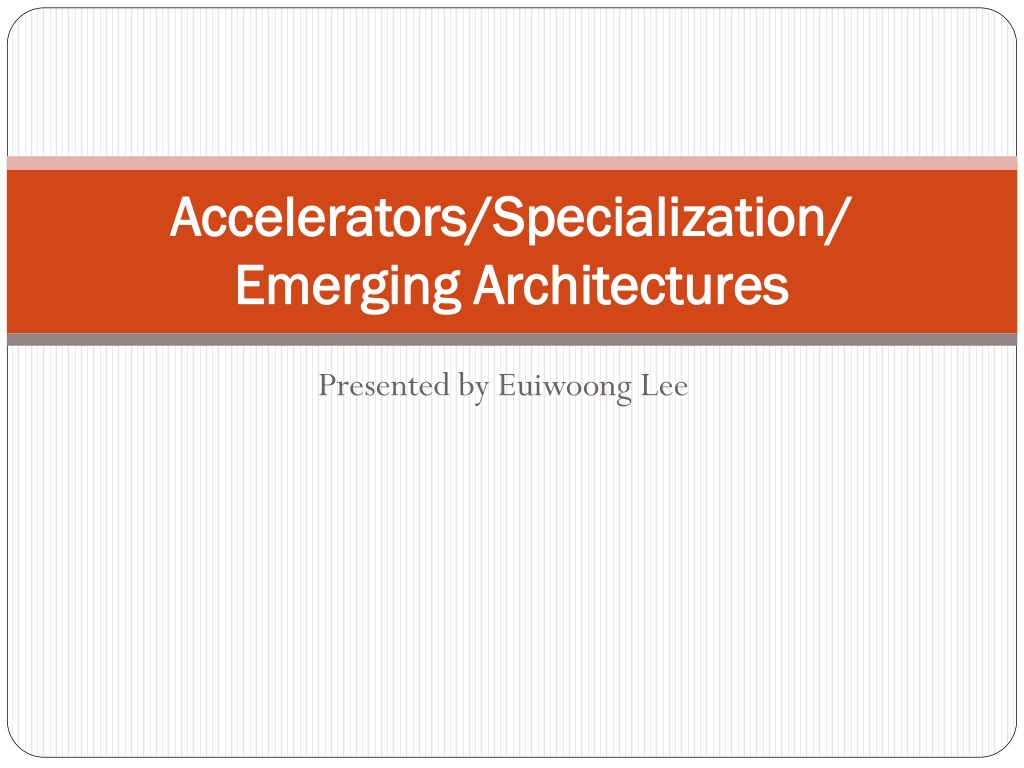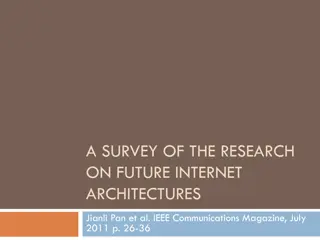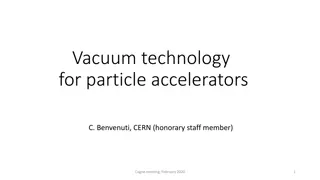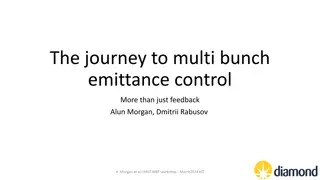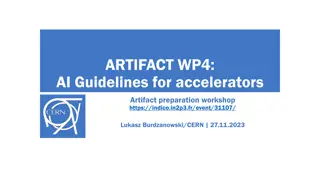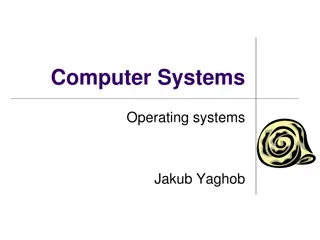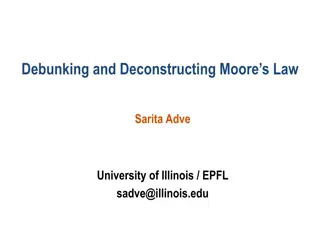Exploring Accelerators and Emerging Architectures in Specialized Computing
Delve into the world of accelerators and specialized computing architectures with a focus on application-specific designs like GPUs and FPGAs. Discover the challenges of performance efficiency and generality in the Iron Triangle paradigm, alongside innovative solutions presented in recent research papers and the spectrum of design choices available.
- Accelerators
- Specialized Computing
- Emerging Architectures
- Application-Specific Designs
- Performance Efficiency
Download Presentation

Please find below an Image/Link to download the presentation.
The content on the website is provided AS IS for your information and personal use only. It may not be sold, licensed, or shared on other websites without obtaining consent from the author. Download presentation by click this link. If you encounter any issues during the download, it is possible that the publisher has removed the file from their server.
E N D
Presentation Transcript
Accelerators/Specialization Accelerators/Specialization/ / Emerging Architectures Emerging Architectures Presented by Euiwoong Lee
Papers Putnam et al.A Reconfigurable Fabric for Accelerating Large- Scale Datacenter Services, in ISCA 2014 St. Amant et al. General-purpose code acceleration with limited-precision analog computation, in ISCA 2014 + Madhavan, Sherwood, Strukov. Race logic: a hardware acceleration for dynamic programming algorithms, in ISCA 2014
Motivation The good days are over. Iron Triangle (from St. Amant et al.) Performance Efficiency Generality We can choose any two at the expense of the third.
Application Specific Designs It will be wasteful to run different programs on the same general-purpose processor. One extreme: CPU The other extreme: ASIC (Application-specific integrated circuit) In between? Beyond the extremes?
Application Specific Designs GPU FPGA: A field-programmable gate array (FPGA) is an integrated circuit designed to be configured by a customer or a designer after manufacturing hence "field- programmable". [wikipedia]
Another dimension How to represent numbers? Currently, we use digital, even for real numbers. Analog? Many choices to measure. How to add, subtract, or apply complicated functions to them?
Spectrum Putnam et al. (general purpose?) Image from Esmaeilzadeh et al. MICRO 2012
Spectrum Putnam et al. (general purpose?) St. Amant et al. (general purpose??) Image from Esmaeilzadeh et al. MICRO 2012
Spectrum Putnam et al. (general purpose?) St. Amant et al. (general purpose??) Madhavan et al. (specific) Image from Esmaeilzadeh et al. MICRO 2012
Papers Putnam et al. A Reconfigurable Fabric for Accelerating Large-Scale Datacenter Services, in ISCA 2014 St. Amant et al. General-purpose code acceleration with limited-precision analog computation, in ISCA 2014 + Madhavan, Sherwood, Strukov. Race logic: a hardware acceleration for dynamic programming algorithms, in ISCA 2014
FPGA Image from www.ni.com
FPGA Main Challenge: The need to fit the accelerated function into the available reconfigurable area. Current reconfiguration times for standard FPGAs are too slow to make this approach practical. Multiple FPGAs provide scalable area, but cost more, consume more power, and are wasteful when unneeded. Using a single small FPGA per server restricts the workloads that may be accelerated, and may make the associated gains too small to justify the cost.
Large-Scale Datacenter Services [Putnam et al. 14] 23 authors! Large-Scale Datacenter reduces variance of load. While reliability is important, the scale of the datacenter permits sufficient redundancy that a small rate of faults and failures is tolerable.
Large-Scale Datacenter Services [Putnam et al. 14] Specialization of individual servers have issues Loses homogeneity Datacenter services evolve extremely rapidly, making non- programmable hardware features impractical
Implementation Attach one FPGA to each server, and connect 48 servers as 6*8 torus
Experiments Attach one FPGA to each server, and connect 48 servers as 6*8 torus Do it 34 times, so total 1632 servers. Actually ran the Bing web search engine. Improved the throughput of each server by 95%.
Papers Putnam et al. A Reconfigurable Fabric for Accelerating Large-Scale Datacenter Services, in ISCA 2014 St. Amant et al. General-purpose code acceleration with limited-precision analog computation, in ISCA 2014 + Madhavan, Sherwood, Strukov. Race logic: a hardware acceleration for dynamic programming algorithms, in ISCA 2014
Motivation Iron Triangle again Performance Efficiency Generality Is there another component whose sacrifice can possibly improve all three? Precision.
Neural Processing Unit [Esmaeilzadeh et al. 12] Tolerance to approximation is one such program characteristic that is growing increasingly important. Key idea: Learn how an original region of approximable code behaves and replace the original code with an efficient computation of the learned model.
Neural Processing Unit [Esmaeilzadeh et al. 12] Programmer marks approximable code. (1) Code observation: Collets data (2) Training: Decides the topology of neural network and its weights. (3) Code generation: Generates a configuration for the NPU that implements the trained neural network, and replaces each call.
Mixed-signal implementation for NPU [St. Amant et al. 14] Numbers are represented in analog ways Currents, Voltages, Resistances. Operations Addition: Kirchhoff s Law (I = I1 + I2) Multiplication: Ohm s Law (V = I * R) Even non-linear functions possible (transistors with saturation mode)
Issues for analog computation (1) Error (2) The amount of information (3) Good for only specific operations (4) Determining where the D/A boundaries lie (5) How to store?
Issues for analog computation (3) Good for only specific operations (4) Determining where the D/A boundaries lie (5) How to store? Their solution: D-A interface is located in a single-neuron level.
NPU with analogue computation (1) Error Errors are inherent, but NPU is built for approximation anyway. Let the compiler do the hard work of estimating / preventing error at once.
Deciding range of values (2) Amount of information: theoretically, can represent all real values? Large value Large voltages and currents => more energy Finer scale Susceptible to noise Their final answer: 8 bits
Deciding topology of network Large degree More parallelism But similar problem as before (e.g. more currents => energy) Their decision: again max. number of inputs = 8
Papers Putnam et al.A Reconfigurable Fabric for Accelerating Large- Scale Datacenter Services, in ISCA 2014 St. Amant et al. General-purpose code acceleration with limited-precision analog computation, in ISCA 2014 + Madhavan, Sherwood, Strukov. Race logic: a hardware acceleration for dynamic programming algorithms, in ISCA 2014
Beyond electricity Real physics or Real chemistry Exotic fully customized systems exploiting novel physics and based on nontraditional technologies D-Wave computer, which utilizes quantum annealing phenomena to solve optimization problems Reaction-diffusion systems made up of 2D chemical substrates can be used to solve 2D Voronoi Diagram Problems
One natural(?) way to represent numbers Time Use the well-studied problem domain of sequence alignment to test the potential of this new logic.
Similarity between sequences Given two strings A and B. How many edits (insertions, deletions, substitutions) do we need to perform to transform A to B? Example: s1 = ACGTGCA s2 = CCTGCAA 3 edits (A -> C, Delete G, Insert A) are enough
Similarity between sequences Generalization Each operation has different scores Even match has nonzero score We can maximize / minimize the score (in maximization, insertion / deletion will have lower score than match) In the following example, score for match = insertion = deletion = 1, substitution = 2 (and will minimize).
Dynamic Programming A C G T G C A C C T G C A A Let ?{?,?} be the minimum edit distance between B1 Bi and A1 Aj.
Dynamic Programming ?{?,?}= min(?? 1,? + ? ,??, ??,? 1 + ? ??, , ??,? +? ??,??) ? ,??, ? ??, ,? ??,?? indicate the cost for deletion, addition, substitution (match) respectively
Dynamic Programming A 2 C G T G C A C C T G C A A
Dynamic Programming A 2 C 2 G 3 T 4 G 5 C 6 A 7 C C T G C A A
Dynamic Programming A 2 3 C 2 3 G 3 4 T 4 5 G 5 6 C 6 7 A 7 8 C C T G C A A
Dynamic Programming A 2 3 4 C 2 3 4 G 3 4 5 T 4 5 5 G 5 6 6 C 6 7 7 A 7 8 8 C C T G C A A
Dynamic Programming A 2 C G T G C A C C T G C A A
Dynamic Programming A 2 3 C 2 G T G C A C C T G C A A
Dynamic Programming A 2 3 4 C 2 3 G 3 T G C A C C T G C A A
Dynamic Programming A 2 3 4 5 C 2 3 4 G 3 4 T 4 G C A C C T G C A A
Dynamic Programming A 2 C 2 G T G C A C C T G C A A
Dynamic Programming A 2 3 C 2 3 G 3 T G C A C C T G C A A
Dynamic Programming A 2 3 4 C 2 3 4 G 3 4 T 4 G C A C C T G C A A
Dynamic Programming A 2 3 4 5 C 2 3 4 5 G 3 4 5 5 T 4 5 5 G 5 C A C C T G C A A
Race Logic Utilizes a new data representation to accelerate a broad class of optimization problems, such as those solved by dynamic programming algorithms The core idea of Race Logic is to use race conditions set up in a circuit to perform useful computation.
Race Logic Utilizes a new data representation to accelerate a broad class of optimization problems, such as those solved by dynamic programming algorithms Score represented as delay time (synchronized) The core idea of Race Logic is to use race conditions set up in a circuit to perform useful computation. Minimization performed as OR (each cell starts to work when the earliest message arrives).
Race Logic deletion sub insertion
